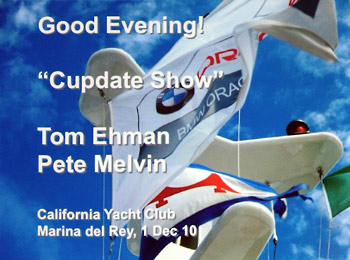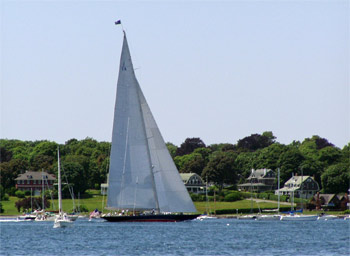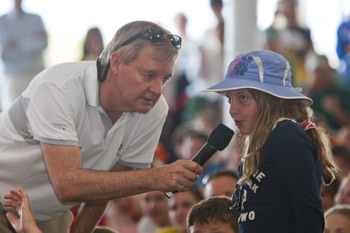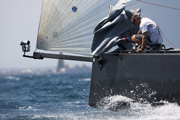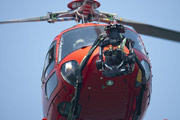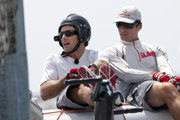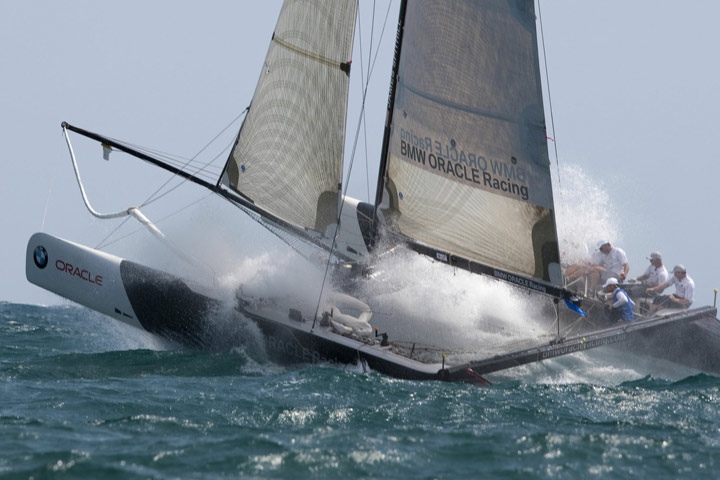|
December 12, 2010 |
|||||||||||||||||||||||||
|
|
|||||||||||||||||||||||||
With dramatic changes in store for the Cup in the three years from now until 2013, Ehman brought “Cupdate 2010” to a standing-room-only crowd. But first -- a history lesson; exactly how did we get here? Professor Ehman drew the throng into the Cup world, illustrating the sequence of events that brought the Cup from its heyday in mainstream America to a fringe sport verging on obscurity. It was a chance for the defender, taking some heat for the extent of changes to the venerable event on their watch, to explain the reasoning behind the direction the Cup is going and to take questions and hear concerns from the knowledgeable audience.
“If you draw a curve of the interest in the America’s Cup,” said Ehman, “the interest from 1851 through the 19 20s was huge, in some part because there really wasn’t much else. But in 1930, they moved the Cup from New York City to Newport, Rhode Island. No, it wasn’t because of the mansions; they could not run the races because of the sheer number of spectator boats and commercial traffic. They moved the Cup to Newport to get away from that -- and Cup interest went downhill. So we’re not taking the Cup to some media-centric era, we’re taking the Cup back to the way the Cup was from 1851 until they moved to Newport. “The balance of power changed in 1970,” continued Ehman, referring to the practice of multiple challenger candidates racing among themselves in order to face the defender. “It did pique some interest initially, as did the little blips in 1983, when Dennis lost the Cup, and in 1987, with the great pictures from Australia. Otherwise, it’s gone steadily downhill. “We’ve got to do something or it’s going to continue to decline -- and when the interest declines, the sport declines as well. We’ve got to do something to regenerate and it’s got to start with the kids. We’ve got to get kids interested in sailing. We’ve taken the Cup out to thank our constituents and a priority has been getting to the kids, to inspire them and get them interested in the technology of the sport.”
According to the defender, the way to grab that interest is to race the America's Cup in multihulls. Russell Coutts’ generationally-targeted “Flintstones versus Facebook”’ comment aside, multihulls plus short racing plus inshore spectators apparently equals the future. “We don’t want to lose our core audience, the life-long sailors,” explained Ehman, “but we’ve got to bring the kids into this, so we’ve got to change the nature of the game. And that’s what Larry and Russell are setting out to do.” To accomplish that objective, Ellison and Coutts turned to Pete Melvin of Morelli & Melvin Design & Engineering. A longtime sailor and a consultant on USA 17’s wing sail, Melvin took on the multihull portion of the study for potential next America’s Cup boat design. After looking at all the options within each design Melvin came up with, together with the monohull portion of the study, America’s Cup organizers opted for the big multihulls -- a decision that, good or bad, will indeed change the game. Click here to read Pete Melvin’s talk on creating the AC72 Multihull Rule There has been much talk about the prospective number of challengers. So far Artemis Racing of Sweden, Aleph Team France, and an unnamed fifth entry have officially signed up, joining Mascalzone and BMW Oracle. Several more teams are gathering momentum and waiting with bated breath for the venue decision. Current talk centers includes even the 10 years. “We’re working really hard to get a second American defender,” said Ehman. “The last time there was a defense trial was 1995, because the winning team wanted to do the whole thing themselves. We -- Russell, Larry, and I -- think we’re much better off having multiple defenders racing off for the right to represent Golden Gate Yacht Club.” First up on the agenda will be the “America’s Cup World Series” events starting in the summer of 2011. Four to six regattas will be scheduled each year -- venues, of course, to be determined. 2011 and 2012 will each constitute its own “World Series” of events, adding up points through the year and declaring a World Champion for the America’s Cup that year, leading into the 2013 America’s Cup. Since the AC72 catamaran won’t be online in time for the first of these events, a smaller one-design version, called the AC45, will be used in 2011. Ehman cited multiple pluses for the AC45, starting with the $600,000 (USD) price tag. If a team is interested in the Cup but not prepared to invest the multiple millions, it can buy an AC45 (after the Cup teams get theirs, of course) and put their toes in the water in 2011. And with the ease of taking the boat apart and transporting it, more venues will be feasible -- places in the world without a harbor deep enough to handle the draft of an old AC monohull. “It’s a much less expensive way to take the Cup and our sport to harbors all around the world. We want to sail close to shore, where people can see it. And the course won’t be your usual windward/leeward. We’ll test some of these new things with the AC45; different course types, having cameramen on board, everything.”
But of all the hot-button issues addressed, the topic of the proposed venue was undoubtedly of the most concern to the California crowd. Two contenders for the right to host the Cup that are under consideration now are San Francisco and an undisclosed coastal city somewhere in Italy, home to Challenger of Record Mascalzone Latino. How and where the World Series regattas proceed depends upon the greatly contested choice of venue -- and much of the choice depends upon the city itself. “The current plan is to do the first regatta next summer in Europe,” announced Ehman. “The most bang for the buck early on is there, there are more teams from Europe. Then, wherever the final venue is, there will be a dress rehearsal there. The last regatta of the World Series events will be there. If it is San Francisco, you’ll see a lot of racing in California from September of 2012 to September of 2013. Once the teams are based here, if San Francisco is the venue, you’ll see a lot of activity here, and maybe Auckland and Sydney as well, because they are so close. “If the final venue is in Europe, we’ll have to rethink that.” While Americans cannot accept a US team defending the Cup anywhere else, picking a venue involves a lot more than just wind and dock space -- it involves a host of logistical issues such as homes, schools, cars, taxes and work visas, to name just a few. “It’s hard for us Americans to imagine, because we can go from California to, say, Maine on the same driver’s license. You get a bunch of people coming to a venue like Spain -- people in the Cup community have lived in Spain for six years, their children have only gone to school in Europe. “So you’ve got to get the venue to help the families, because they’re going to come live here for a year,” said Ehman. “To get a driver’s license in a foreign language is really difficult. I’ve got a German driver’s license, it took me three bloody years to get it! So first you have to get all the regulations handled: and that means dealing with Sacramento (cue the sound of the entire crowd groaning). We have met with Governor Schwarzenegger. You have to get the state government interested, you’ve got to get these regulations sorted, so families can move there and live and operate. Sounds easy, doesn’t it? It’s not, it’s quite hard. For example, how do you deal with health insurance for a thousand people coming into California? So that’s the first thing, figuring out how to handle the logistics. “Second, we have to have the financial support
to do this. The problem is, you don’t want your hard-earned
tax dollars going to an event, even an event that brings a
billion dollars into the local economy. We have asked --
and the city of San Francisco has agreed -- to help raise $270
million from corporate sponsors. We’re meeting with a lot
of companies up there to help raise that money, to get the
financial support to run the television show, to run the
pre-regattas, everything.
“The third thing is it really does come down to having a fantastic patch of water and a fantastic shore site. In Valencia, we did -- they spent €380 million to create that harbor. We won’t spend that here, or anywhere else, because in these economic times, it’s just not possible. But the great advantage in San Francisco, provided we can sort all those other things out, is not just the wind, it’s not just the velocity, it’s the reliability. At 2:00 on most days between May and September, you can start a yacht race. Which means you can tell the sponsors that they can bring their guests and put them on the spectator boat. You can tell the public to come down and have a look because the boats are going to go out and go yacht racing and you’ll be able to watch it along the city front. And you can tell the world-wide television audience when the yacht race will start, rather than losing most of your audience during a delay.” No delays anymore – it’s full steam ahead for the next America’s Cup. And next up on the agenda – the venue announcement, sometime before December 31. Hold onto your hats… --Diane Swintal for CupInfo/©2010
CupInfo |
|||||||||||||||||||||||||
Links of Interest: 10:30 pm PT Dec 12 2010 |
|||||||||||||||||||||||||
